Probabilistic Estimation of the Energy Consumption and Performance of the Lighting Systems of Road Tunnels for Investment Decision Making
Abstract
:1. Introduction
2. Recall and Improvements of the Model EST
2.1. The Technical Module TM
- -
- 100 W sodium high pressure (SHP) lamps, with 14 W of auxiliary circuits, reduced power during the night to 59 W with invariant power of auxiliary circuits;
- -
- efficiency equal to 61 lm/W;
- -
- the lamps have a color rendering index not greater than 60 so that the lighting category of the road is not reduced;
- -
- 13 h of operation during the morning, 11 h of operation during the night, 365 days of annual operation;
- -
- height of whitewashed walls equal to 3.0 m;
- -
- LSTs which have the lines of luminaires equipped with lamps placed sideways are assimilated to the ones with luminaires equipped with lamps placed in line above the roadway:
- -
- for the short tunnels, e.g., those according to [2] of length up to 125 m, the lighting level is assumed equal to 100% of that provided for the long galleries.
- -
- single central line of luminaries with 10 m of spacing, 100 luminaires/Km;
- -
- double central line of luminaries with 9 m of spacing, 222 luminaires/Km;
- -
- triple central line of luminaries with 9 m of spacing, 333 luminaires/Km.
- -
- New SHP: substituting sodium high-pressure discharge (SHP) with higher efficiency for the existing SHP;
- -
- LED: substituting LED luminaires (SHP) for the existing SHP.
2.2. The Economic Module EM
2.3. Intermediate and Final Outputs of EST
- (i)
- representation on the same Cartesian plane of all EST, with reference to a set of LSTs, ar the LSTs of interest in the actual state of service;
- (ii)
- identification on the same Cartesian plane which LST is in an acceptable state of service (second quadrant), which LST needs intervention for reducing the energy consumptions and/or improving the lighting performance;
- (iii)
- representation on the same Cartesian plane of the effect of the interventions on every LST adopting one of the possible alternatives (substituting the luminaries and/or integrating luminosity regulation);
- (iv)
- economic evaluation of every intervention on each LST;
- (v)
- sorting of the alternative solutions by means of the economic quantities NPVSk or PBk.
3. Probabilistic Energy Screening of Tunnel, PrEST
3.1. Lamp and Luminaires
3.2. Economic Data and Parameters
3.3. Probabilistic Analysis Technique
- -
- by the TM: ∆ECi and ∆LPi, computed by Equations (1) and (2), respectively,
- -
- by the EM: NPVSk and PBk, computed by the Equations (10) and (23), respectively.
- -
- , the probability density function of the variation index of the annual energy consumption, ∆ECi;
- -
- , the probability density function of the lighting performance, ∆LPi;
- -
- , the probability density function of the present worth of the total savings, NPVSk;
- -
- , the probability density function of the pay-back period, PBk.
4. Numerical Applications on Real Tunnels
- (i)
- the efficiency of the lamps;
- (ii)
- the life of the lamps.
- (a)
- number of luminaires equipped with lamps equal to those currently installed (design condition—D.C.); this is a common case in which the new LST uses the same structure and the same lamp positioning of the existing LST;
- (b)
- number of luminaires equipped with lamps obtained by means of an adaptive procedure (A.P.) that allows for installing the minimum number of luminaires equipped with lamps which guarantees, for the nominal value of efficiency, the location of the LST in the second quadrant of the Cartesian plane {electricity consumption, performance}; this is a case in which a design activity, separated from PrEST, defines a structure and a positioning of the luminaires equipped with lamps different from the existing LST.
5. Discussion
6. Conclusions
Author Contributions
Funding
Acknowledgments
Conflicts of Interest
Abbreviations
| (X)os | X quantity referred to the old solution |
| (X)k | X quantity referred to the new k solution |
| CMatnh | hourly cost of all the materials with the exclusion of the lamps and luminaires at the year n |
| cost of electric energy at the year n | |
| hourly cost of the electric energy consumptions at the year n | |
| hourly cost of further possible interventions in the year n | |
| costs for acquiring and installing the lamps at year n | |
| costs for acquiring and installing the luminaries at year n | |
| hourly cost of the maintenance cost in the year n | |
| ECi (ECi*) | index of energy consumptions per kilometre of the LSTi (LST*i) |
| KAn | cost of the lighting systems of a tunnel (LST) at year n |
| KAIn | costs for acquiring the lamps and the luminaires at year n |
| KAOn | costs different to cost of lamps and luminaires at year n |
| hourly cost of KAOn | |
| H | number of operation hours during each year n |
| annual cost, other than the annual energy cost, to be incurred in each year n | |
| LPi (LPi*) | the index of illuminance of the LSTi (LSTi*) |
| nominal life in years of lamps of the jth solution | |
| nominal life in years of luminaires of the jth solution | |
| nominal life in years of materials of the jth solution | |
| expressed in hours | |
| expressed in hours | |
| expressed in hours | |
| j | number of lamp substitution in the period N of the jth solution |
| N | period of the financial evaluation in years |
| NPVSj | net present value of the total savings for the jth solution |
| PBj | discounted payback period for the jth solution |
| rate of return | |
| β | variation rate of the energy cost |
| ε | lamp efficiency |
Appendix A
References
- Bullough, J.D.; Zhang, X.; Skinner, N.P.; Rea, M.S. Design and Evaluation of Effective Crosswalk Illumination. In PDF FHWA-NJ-2009-03 [Report to the New Jersey Department of Transportation]; New Jersey Department of Transportation: Trenton, NJ, USA, 2009. [Google Scholar]
- UNI 11095. Light and Lighting: Tunnel Lighting; UNI Unification Italian Committee: Italy, 2003. [Google Scholar]
- Ying, Y. Study on the Computing Method of Luminance of Tunnel Threshold Zone; Chongqing University: Chongqing, China, 2008. [Google Scholar]
- Li, F.; Chen, D.; Song, X.; Chen, Y. LEDs: A Promising Energy-Saving Light Source for Road Lighting. In Proceedings of the Power and Energy Engineering Conference, APFEEC 2009, Wuhan, China, 28–31 March 2009. [Google Scholar]
- Salata, F.; Golasi, I.; Bombelli, E.; de Lieto Vollaro, E.; Nardecchia, F.; Pagliaro, F.; Gugliermetti, F.; de Lieto Vollaro, A. Case Study on Economic Return on Investments for Safety and Emergency Lighting in Road Tunnels. Sustainability 2015, 7, 9809–9822. [Google Scholar] [CrossRef] [Green Version]
- Parise, G.; Martirano, L.; Parise, L. The energetic impact of the lighting system in the road tunnels. In Proceedings of the 2015 IEEE/IAS 51st Industrial & Commercial Power Systems Technical Conference (I&CPS), Calgary, AB, Canada, 5–8 May 2015; pp. 1–7. [Google Scholar]
- Salata, F.; Golasi, I.; Bovenzi, S.; Vollaro, E.L.; Pagliaro, F.; Cellucci, L.; Coppi, M.; Gugliermetti, F.; Vollaro, A.L. Energy Optimization of Road Tunnel Lighting Systems. Sustainability 2015, 7, 9664–9680. [Google Scholar] [CrossRef] [Green Version]
- Caporaso, F.; Montecuollo, M.; Verde, P.; Varilone, P. Energy Savings and Performance Modelling of Tunnel Lighting Systems for Decision Making of Investments. World Road Assoc.–PIARC 2015, 366, 82–87. [Google Scholar]
- Varilone, P.; Verde, P.; Caporaso, F.; Cesolini, E.; Drusin, S. Integrated modelling and experimental verification of energy consumption and performance of the lighting systems of tunnels. In Proceedings of the AEIT Annual Conference, Trieste, Italy, 18–19 September 2014. [Google Scholar]
- ARERA, Resolution EEN 4/11, 5 Maggio 2011. Available online: www.arera.it/it/docs/11/004-11een.htm (accessed on 1 February 2019).
- Energy Efficient Lighting. Available online: www.ncsl.org/research/energy/energy-efficient-lighting.aspx (accessed on 1 February 2019).
- Free Software Dialux. Available online: https:// dial.de/en/ (accessed on 1 February 2019).
- International Commission on Illumination. Available online: www.cie.co.at (accessed on 1 February 2019).
- Luo, D.; Chen, Q.; Gao, Y.; Zhang, M.; Liu, B. Extremely Simplified, High-Performance, and Doping-Free White Organic Light-Emitting Diodes Based on a Single Thermally Activated Delayed Fluorescent Emitter. ACS Energy Lett. 2018, 3, 1531–1538. [Google Scholar] [CrossRef]
- Liu, B.; Nie, H.; Zhou, X.; Hu, S.; Luo, D.; Gao, D.; Zou, J.; Xu, M.; Wang, L.; Zhao, Z.; et al. Manipulation of Charge and Exciton Distribution Based on Blue Aggregation-Induced Emission Fluorophors: A Novel Concept to Achieve High-Performance Hybrid White Organic Light-Emitting Diodes. Adv. Funct. Mater. 2016, 26, 776–783. [Google Scholar] [CrossRef]
- Liu, B.Q.; Wang, L.; Gao, D.Y.; Zou, J.H.; Ning, H.L.; Peng, J.B.; Cao, Y. Extremely high-efficiency and ultrasimplified hybrid white organic light-emitting diodes exploiting double multifunctional blue emitting layers. Light Sci. Appl. 2016, 5, e16137. [Google Scholar] [CrossRef] [PubMed]
- ANSI/IES RP-16-17, Nomenclature and Definitions for Illuminating Engineering. Available online: https://www.ies.org/standards/definitions/ (accessed on 1 February 2019).
- Next Generation Lighting Industry Alliance LED Systems Reliability Consortium, Led Luminaire Lifetime: Recommendations for Testing and Reporting, 3rd ed.; Next Gen. Lighting Ind.: Washington, DC, USA, 2014.
- Lall, P.; Wei, J. Prediction of L70 Life and Assessment of Color Shift for Solid-State Lighting Using Kalman Filter and Extended Kalman Filter-Based Models. IEEE Trans. Device Mater. Reliab. 2015, 15, 54–68. [Google Scholar] [CrossRef]
- Pattison, P.M.; Hansen, M.; Tsao, J.Y. LED lighting efficacy: Status and directions. C. R. Phys. 2017, 19, 134–145. [Google Scholar] [CrossRef]
- Papoulis, A. Probability and Statistics; Prentice-Hall: Upper Saddle River, NJ, USA, 1989. [Google Scholar]
- ANAS (Azienda Nazionale Autonoma Delle Strade). Manutenzione Ordinaria. Available online: https://www.stradeanas.it/sites/default/files/pdf/4.5/MO_LISTINO%20PREZZI%202018.pdf (accessed on 30 January 2019). (In Italian).
- ANAS (Azienda Nazionale Autonoma Delle Strade). Nuove Costruzioni e Manutenzione Straordinaria. Available online: https://www.stradeanas.it/sites/default/files/pdf/4.5/NC-MS_LISTINO%20PREZZI%202018_REV2.pdf (accessed on 30 January 2019). (In Italian).
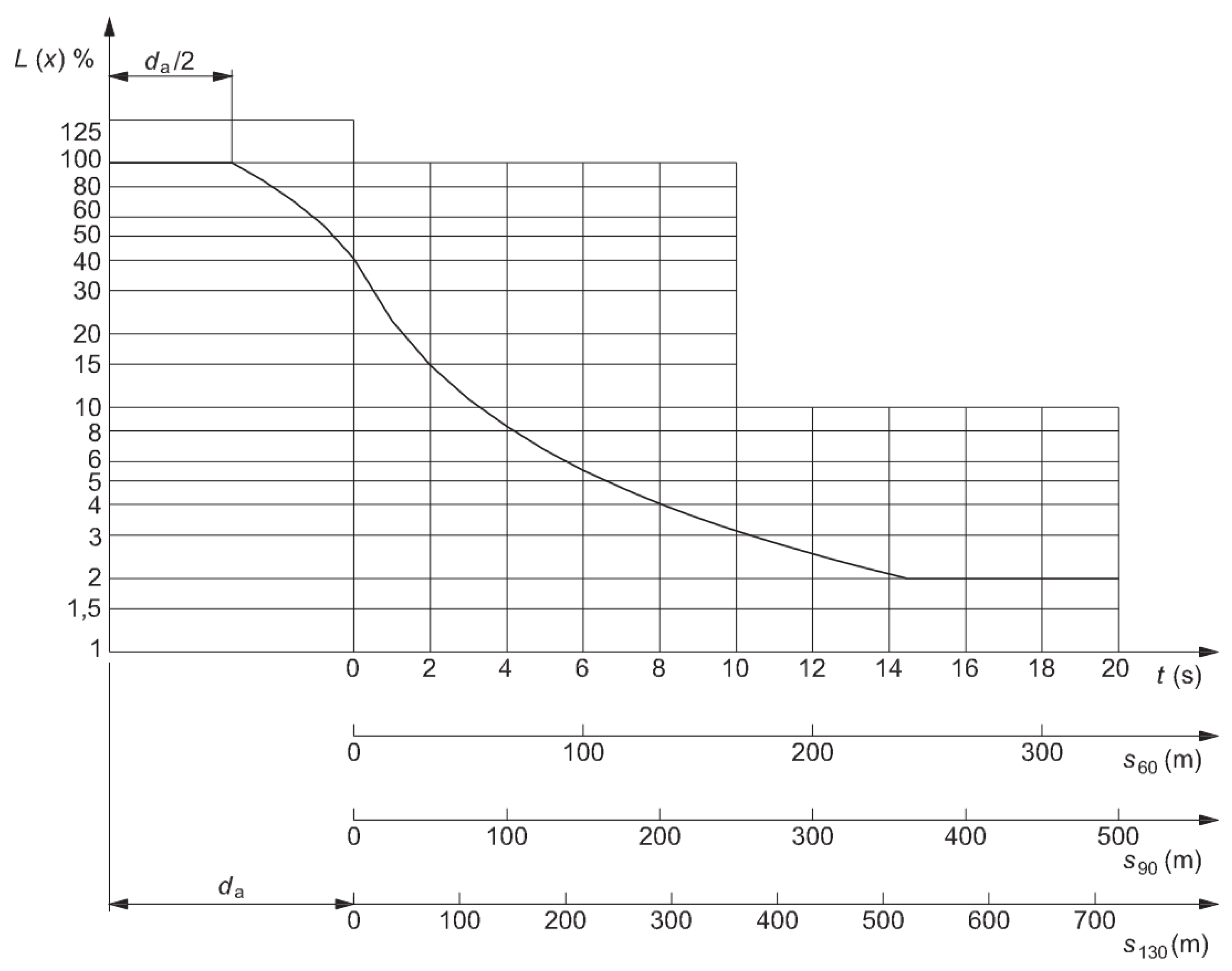
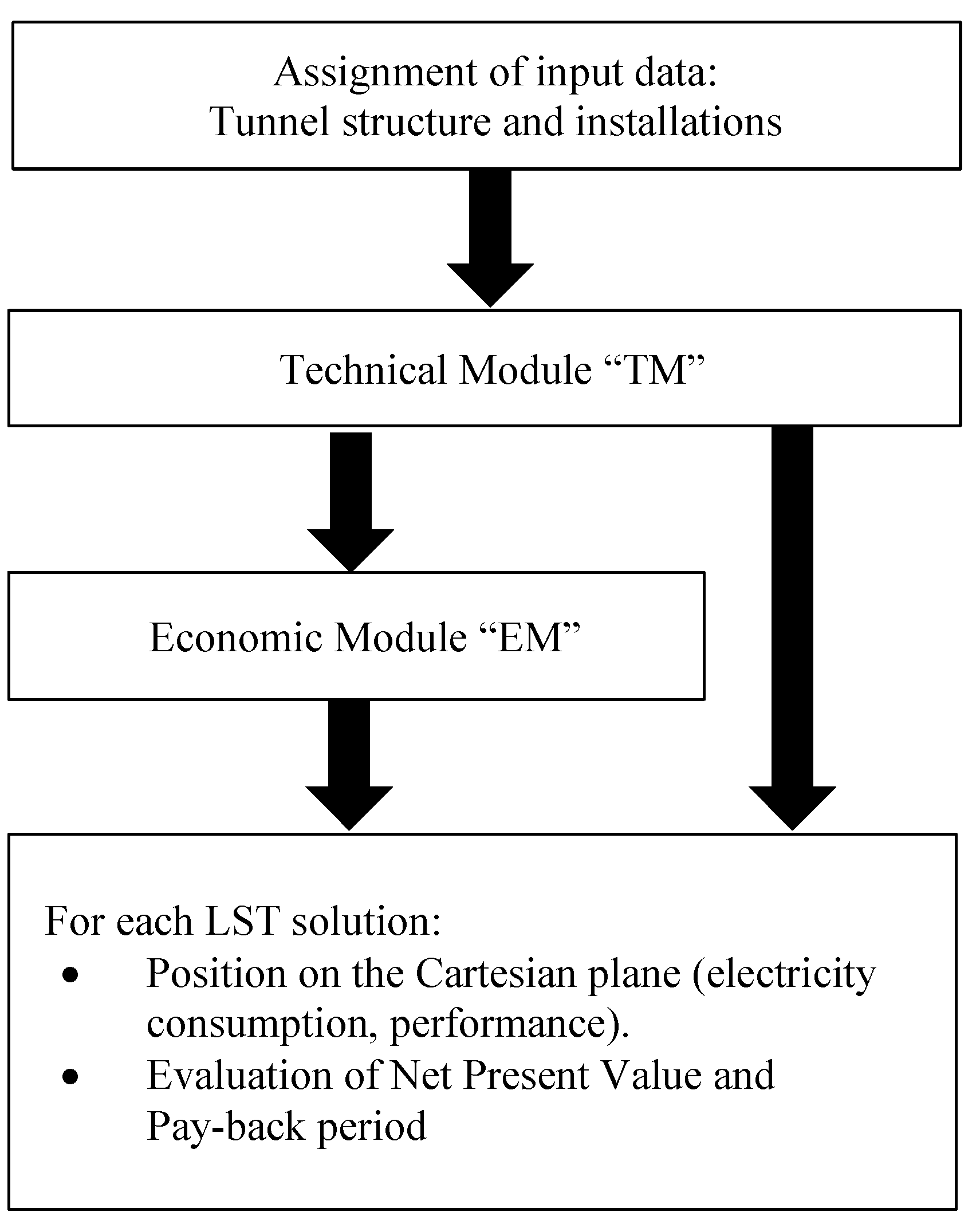
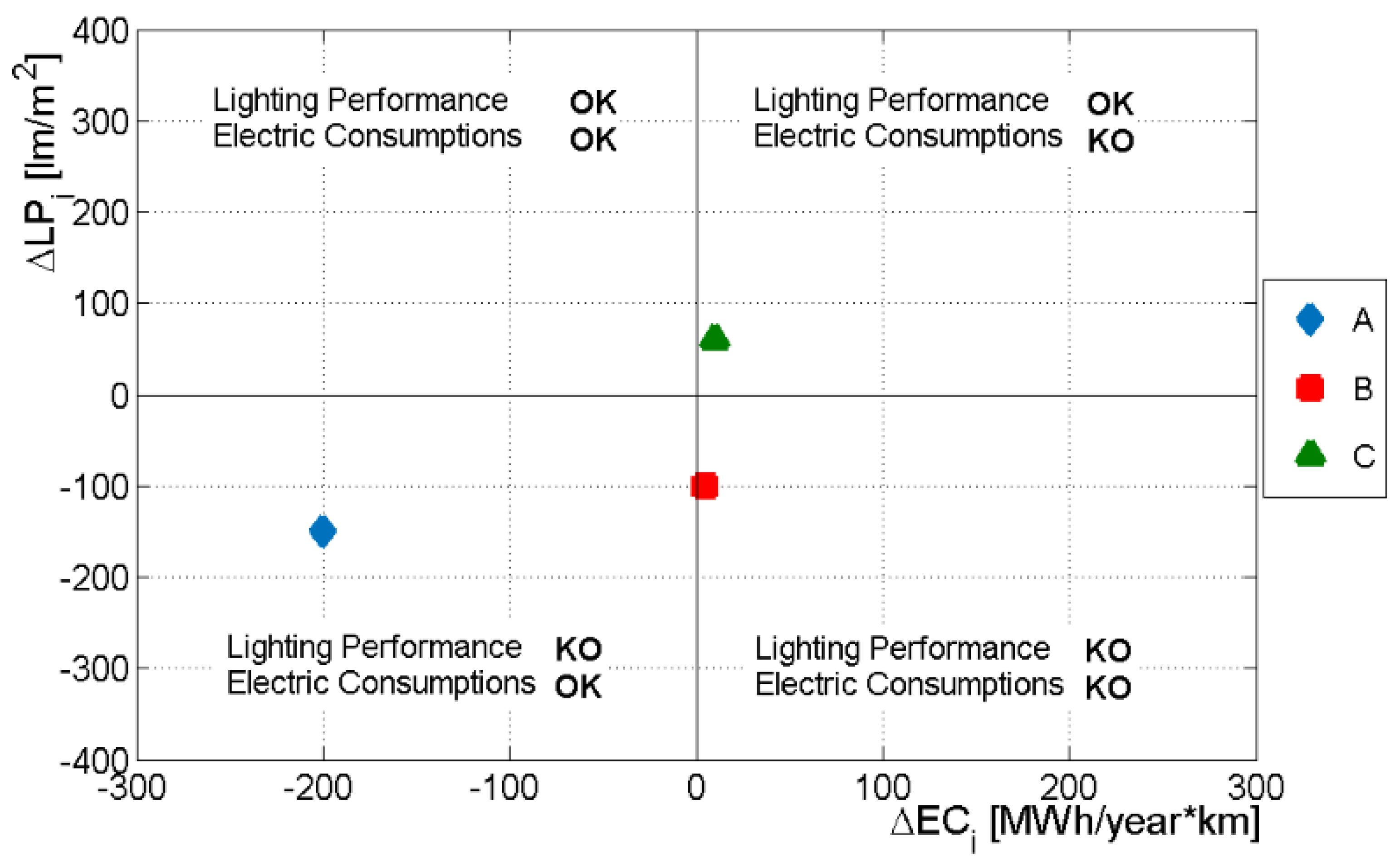
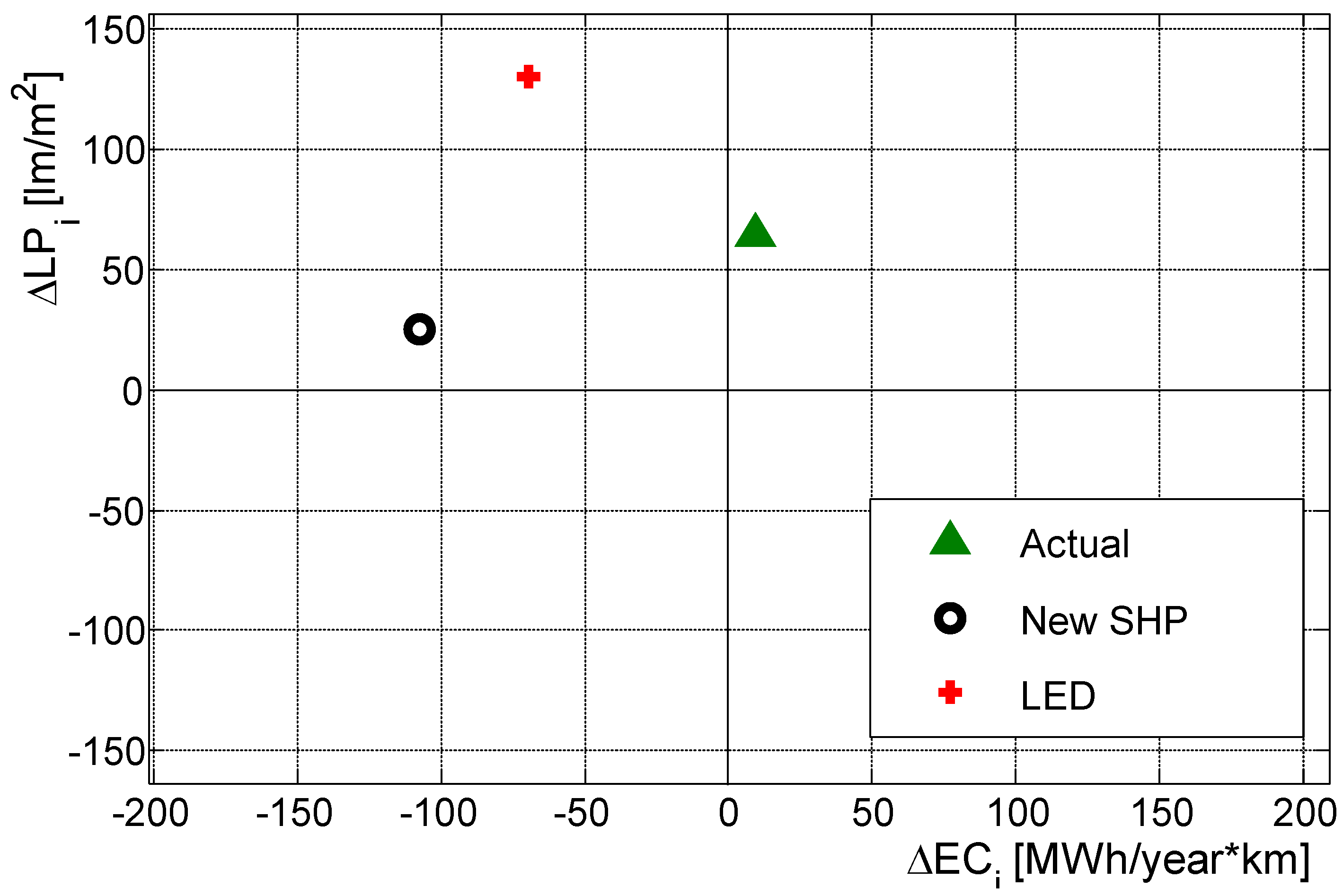
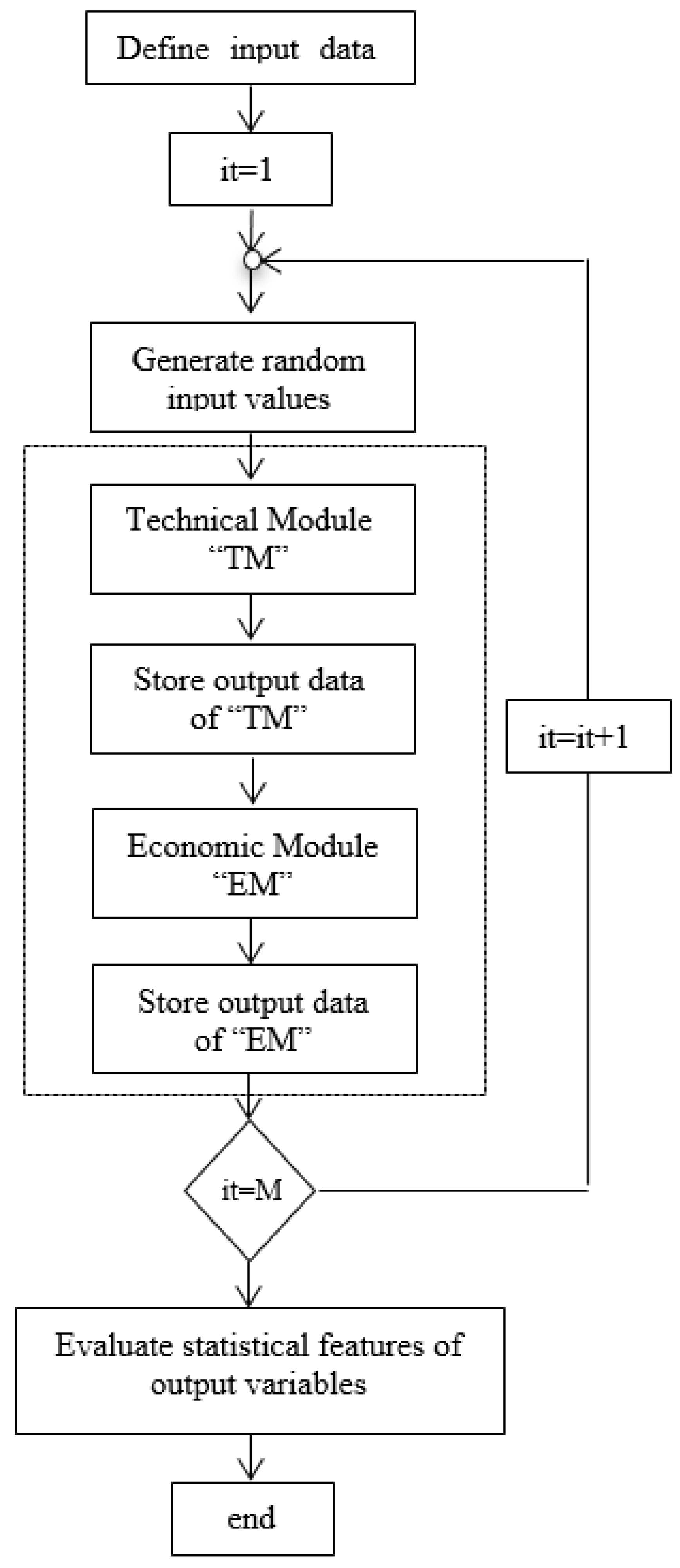

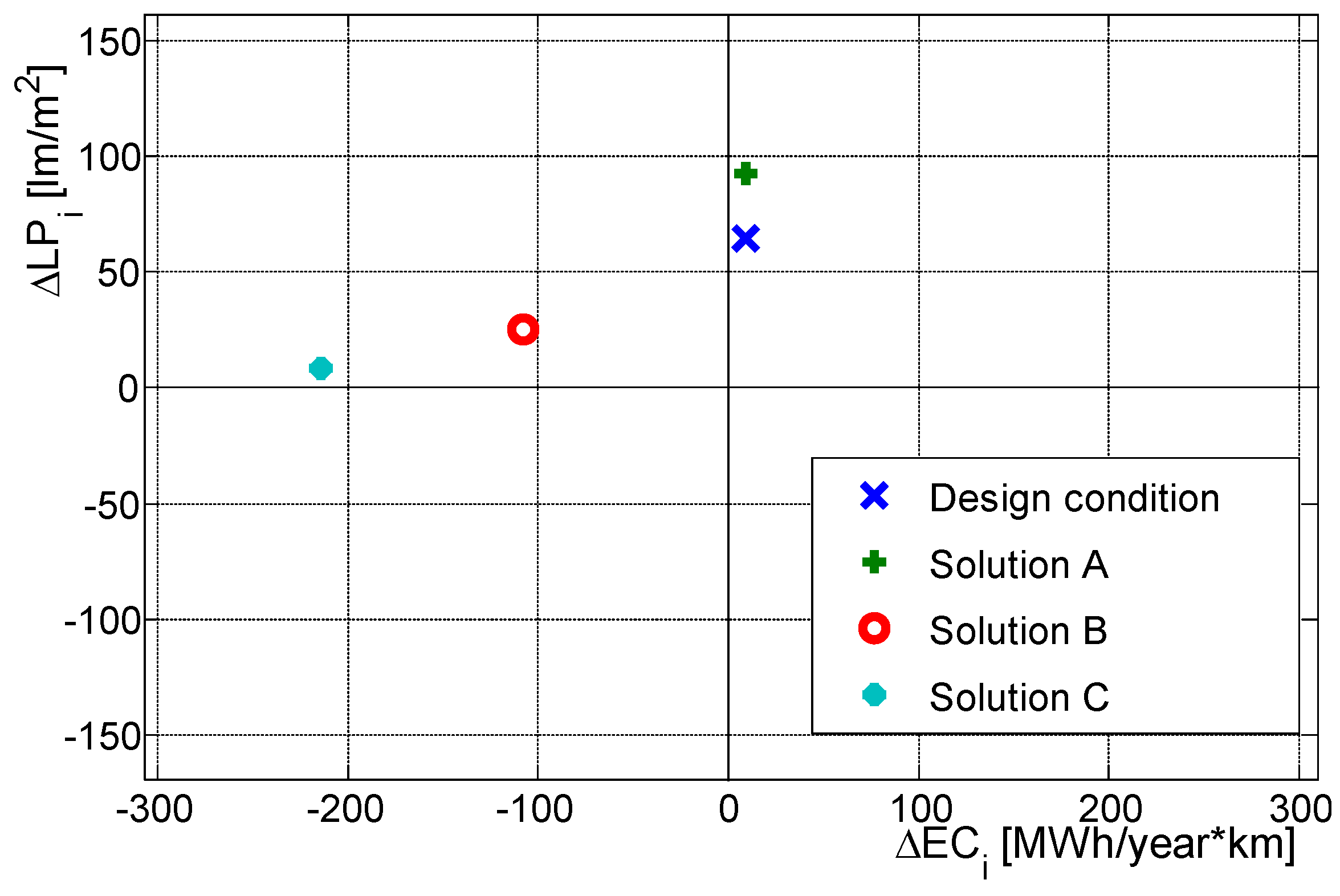


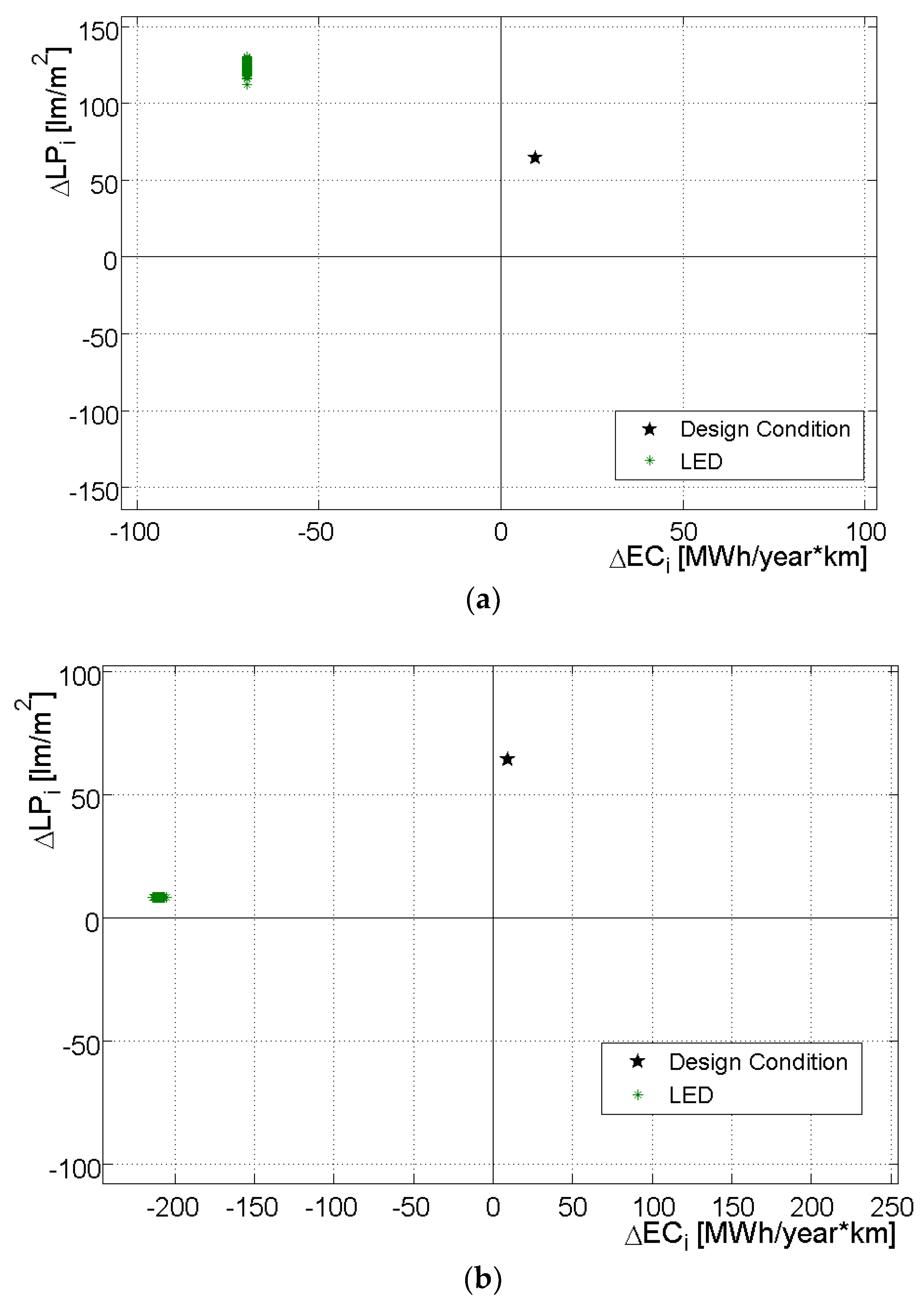

| Name | Length [m] | Speed [Km/h] | Type of Road | Actual Lighting Solution | ||||
|---|---|---|---|---|---|---|---|---|
| Number of Carriageways | Number of Directions | Number of Lanes in Each Direction | Permanent | Reinforcement | εp [lm/W] | |||
| Tunnel 1 | 445.8 | 80 | l | 2 | 1 | 40 SHP 150 W | 62 SHP 400 W | 95 |
| Tunnel 2 | 1472.0 | 70 | 1 | 2 | 1 | 234 SHP 150 W | 98 SHP 400W | 120 |
| Solution | Number of Lamps | NPVS Percentile [k€] | PB Percentile [Year] | ||||
|---|---|---|---|---|---|---|---|
| 5th | 95th | 5th | 95th | ||||
| C | D.C. | 143.1 | 143.1 | 143.1 | 7.5 | 7.5 | 7.5 |
| Solution | Number of Lamps | NPVS Percentile [k€] | PB Percentile [Year] | ||||
|---|---|---|---|---|---|---|---|
| 5th | 95th | 5th | 95th | ||||
| C | D.C. | 130.5 | 104.9 | 150.1 | 7 | 6.5 | 9.5 |
| A.P. | 224.6 | 206.4 | 240.0 | 3.9 | 3.5 | 4.5 | |
| Solution | Number of Lamps | NPVS Percentile [k€] | PB Percentile [Year] | ||||
|---|---|---|---|---|---|---|---|
| 5th | 95th | 5th | 95th | ||||
| B | D.C. | 591.3 | 591.3 | 591.3 | 1 | 1 | 1 |
| C | D.C. | 71.4 | 71.4 | 71.4 | 15.5 | 15.5 | 15.5 |
| Solution | Number of Lamps | NPVS Percentile [k€] | PB Percentile [Year] | ||||
|---|---|---|---|---|---|---|---|
| 5th | 95th | 5th | 95th | ||||
| B | D.C. | 566.9 | 528.6 | 592.2 | 1 | 1 | 1 |
| A.P. | 746.9 | 713.7 | 767.6 | 1 | 1 | 1 | |
| C | D.C. | 2.5 | −84.6 | 75.0 | 19.4 | 15.5 | >20 |
| A.P. | 1011 | 967.5 | 1043 | 1.5 | 1.5 | 1.5 | |
© 2019 by the authors. Licensee MDPI, Basel, Switzerland. This article is an open access article distributed under the terms and conditions of the Creative Commons Attribution (CC BY) license (http://creativecommons.org/licenses/by/4.0/).
Share and Cite
Bracale, A.; Caramia, P.; Varilone, P.; Verde, P. Probabilistic Estimation of the Energy Consumption and Performance of the Lighting Systems of Road Tunnels for Investment Decision Making. Energies 2019, 12, 1488. https://doi.org/10.3390/en12081488
Bracale A, Caramia P, Varilone P, Verde P. Probabilistic Estimation of the Energy Consumption and Performance of the Lighting Systems of Road Tunnels for Investment Decision Making. Energies. 2019; 12(8):1488. https://doi.org/10.3390/en12081488
Chicago/Turabian StyleBracale, Antonio, Pierluigi Caramia, Pietro Varilone, and Paola Verde. 2019. "Probabilistic Estimation of the Energy Consumption and Performance of the Lighting Systems of Road Tunnels for Investment Decision Making" Energies 12, no. 8: 1488. https://doi.org/10.3390/en12081488








